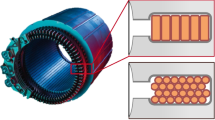Abstract
The geodesic winding trajectory for six degrees of freedom industrial robot with a composite elbow is studied. The parameter variation caused by the enveloping form, length of the hanging filament, and geodesic winding is considered, and the resulting influences on kinetic stability of the robot elbow winding are analyzed. Then the winding trajectories of a robot elbow with different winding strategies are calculated, and the well planned winding trajectory of the elbow is given. Based on a closed loop simulation system which is composed of ADAMS and MATLAB, the elbow winding motion and the robot winding motion space prediction simulation is carried out. After the simulation, a post-processing is used on the elbow planning winding trajectory, and then an executable instruction document of the robot elbow winding was generated. Finally, an experiment on the composite elbow dry fiber winding is used to show that the designed winding trajectory of a composite elbow can stabilize the winding pattern; also, the slip yarn, overhead, and other problems are avoided. In addition, the winding precision completely meets the design requirements. The movement of the robot is smooth, and the actual workspace of the robot elbow winding trajectory is consistent with the simulation workspace.
Similar content being viewed by others
References
Shi YY, Yu T, He XD et al (2015) Mechanism and optimization of process parameters coupling for composite tape winding. Acta Materiae Compositae Sin 32:831–839. doi:10.13801/j.cnki.fhclxb.20150609.003
Shirinzadeh B, Cassidy G, Oetomo D et al (2007) Trajectory generation for open-contoured structures in robotic fibre placement. Robot Comput- Integr Manuf 105:380–394. doi:10.1016/j.rcim.2006.04.006
Rahman H, Jamshed R, Khan A et al (2012) Design of tape wound composite cylindrical shells incorporating different failure criteria and winding kinematics. Adv Mater Res 570:53–62. doi:10.4028/ www.scientific.net/AMR. 570.53
Koussios S, Zu L, Wentzel CM et al (2012) Filament winding: process overview & novel developments. In: International SAMPE Technical Conference, Society for the Advancement of Material and Process Engineering. Baltimore, pp 465–466
Polini W, Sorrentino L (2006) Actual safety distance and winding tension to manufacture full section parts by robotized filament winding. J Eng Mater Technol-Trans ASME 128:393–400. doi:10.1115/1.2203099
Polini W, Sorrentino L (2006) AR models to forecast roving tension trend in a robotized filament winding cell. Mater Manuf Process 21:870–876. doi:10.1080/10426910600746015
Polini W, Sorrentino L (2005) Winding trajectory and winding time in robotized filament winding of asymmetric shape parts. J Compos Mater 39:1391–1411. doi:10.1177/0021998305050431
Polini W, Sorrentino L (2005) Influence of winding speed and winding trajectory on tension in robotized filament winding of full section parts. Compos Sci Technol 65:1574–1581. doi:10.1016/j.compscitech.2005.01.007
Aized T, Shirinzadeh B (2011) Robotic fiber placement process analysis and optimization using response surface method. Int J Adv Manuf Technol 55:393–404. doi:10.1007/s00170-010-3028-1
Tian LF, Collins C (2004) An effective robot trajectory planning method using a genetic algorithm. Mechatronics 14:455–470. doi:10.1016/j.mechatronics. 2003.10.001
Toussaint M (2009) Robot trajectory optimization using approximate inference. In: Proceedings of the 26th International Conference On Machine Learning. Montreal, QC, Canada, pp 1049–1056
Wang GY, Cao J, Li CW (2011) Winding technology of composite elbow based on dual-port RAM of PMAC. In: 2011 International Conference on Computer Science and Service System, IEEE Computer Society. Northeast Forestry University, Harbin, pp 2842–2845
Raterink JC, Taniq SMN, Koussios S (2009) Improving the performance of fiber reinforced pressurizable products. Rubber World 240:23–25 ISSN: 00359572
Karney CFF (2013) Algorithms for geodesics. J Geod 87:43–55. doi:10.1007/s00190-012-0578-z
Denavit J, Hartenberg RS (1955) A kinematic notation for lower-pair mechanisms based on matrices. J Appl Mech 22:215–221
Liu J, Gong SL, Song J et al (2014) Design and simulation of virtual prototype for eggplant picking robot. Mach Tool Hydraul 42:60–63. doi:10.3969/j.issn.1001-3881.2014.21.016
Author information
Authors and Affiliations
Corresponding author
Rights and permissions
About this article
Cite this article
Xu, J., Yang, H., Liu, M. et al. Research on winding trajectory planning for elbow pipe based on industrial robot. Int J Adv Manuf Technol 93, 537–545 (2017). https://doi.org/10.1007/s00170-017-0568-7
Received:
Accepted:
Published:
Issue Date:
DOI: https://doi.org/10.1007/s00170-017-0568-7




